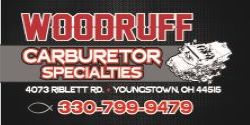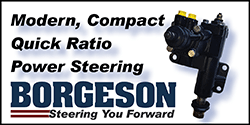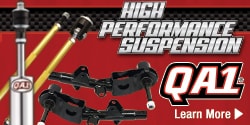You are using an out of date browser. It may not display this or other websites correctly.
You should upgrade or use an alternative browser.
You should upgrade or use an alternative browser.
340 Chugging instead of Reving
- Thread starter 1969GTS340
- Start date
-
Inertia
Well-Known Member
I think the plugs are telling you a story .
Phreakish
Well-Known Member
Rat I agree about the cam timing should have been degreed in.
If the cam timing were way off wouldn't it run poorly through out the entire rpm range? Food for thought.
The plugs a pig rich but that again would not cause a sudden change at 3000 rpm.
Im inclined to point fingers at the ignition system like other members have suggested.
I once had a ohc engine thst I screwed up the cam alignment on, advanced something like 14deg (about 1 timing tooth) and it would rev to about 2800 and then pop, fart, spit and buck.
Completely different engine, but similar behavior, so I wouldn't ignore the cam timing... Just my take.
1969GTS340
Well-Known Member
I noticed that while none of the plugs look great, the odd bank plugs seem noticeably darker. Seems odd, maybe just me. I was going to suggest a different set, or even a different brand. I had more of a high speed miss once. Changed out all my ignition parts before the plugs. Wound up being the plugs. Had switched from Champion to NGK. Put my old Champions in and guess what? Yep. I would have never thought either. Now with that being said, I use NGK plugs yet. Champion quality seems to be in the shitter these days.
What plugs are you running.
Since you didn’t degree the cam, take off the drivers side valve cover. Roll the engine over until you are TDC on over overlap (180 degrees from number 1 firing) and look at your valves.
If both valves are open the same, you are at split overlap and the cam is in straight up, whatever that is.
If the intake valve is open more than the exhaust valve, the cam is advanced from split overlap (straight up). You won’t know exactly how much, but you will know it’s advanced.
If the exhaust valve is open more than the intake valve, the cam is retarded from split overlap (straight up). You won’t know how much, but you will know its retarded.
Like I said, something is weird. I’m thinking cam timing is the first place I’d check.
At 180* overlap from #1 compression stroke. The exhaust valve is open and the intake is completely closed.
1969GTS340
Well-Known Member
This is the 750 Holley and modle numbers

NGK. The engine I had this issue with was an iron headed, high compression, stock stroke 360. Ran the old N9YC plugs for years with no issues. Put in the NGK at the beginning of a season and had the issue. Had replaced the tune up parts as well, in preparation for said season. I replaced EVERYTHING trying to find my miss. Coil, distributor, ECU, plug wires, etc. Plugs were last on the list and guess what? Lol.
Have you verified valvetrain geometries with those rockers? If running chebby rockers, it can be finicky.
1969GTS340
Well-Known Member
Have you verified valvetrain geometries with those rockers? If running chebby rockers, it can be finicky.[/QUOTE
I'm running EQ Magnum heads that use that style rockers. By finicky, do you mean being exact on lash or other?
I put together an EQ headed 360 dirt engine for a local guy. The "cost effective" thing to do is use chevy rockers. Used the Comp 1.6 chevy. After the fact, I learned you need the 1.65 ratio chevys in order to come back to the actual 1.6 of the Magnum. With the 1.6 chevy, I lost lift and couldn't get the geometry correct. No matter what I did with pushrod length.
1969GTS340
Well-Known Member
I put together an EQ headed 360 dirt engine for a local guy. The "cost effective" thing to do is use chevy rockers. Used the Comp 1.6 chevy. After the fact, I learned you need the 1.65 ratio chevys in order to come back to the actual 1.6 of the Magnum. With the 1.6 chevy, I lost lift and couldn't get the geometry correct. No matter what I did with pushrod length.
That's interesting. I checked geometry as far as pushrod clearance and centered the roller on the valve stem. Never verified lift... another assumption.
Good point. There seems to be a lot of issues with the performance ignition systems. Visit the drag strip. Everybody runs MSD and everyone has a extra ignition box or two. What does that tell you?As to your Hi-fire, is that a CDI with Multi-strike?
Does that switch to Single-Fire at 3000, like the MSD?
lol........
512Stroker
We are all here because we are not all there.
Hell Mike I carry a spare orange ignition box in the trunk of my street car.Good point. There seems to be a lot of issues with the performance ignition systems. Visit the drag strip. Everybody runs MSD and everyone has a extra ignition box or two. What does that tell you?
After failing a 6AL box and an MSD pickup I switched over to an complete FBO ignition sytem 3 years ago and haven't looked back.
TT5.9mag
Two atmospheres are better than one
You need to get a degree wheel on that thing. At split overlap, installed straight up, both valves should be open an equal amount.What plugs are you running.
At 180* overlap from #1 compression stroke. The exhaust valve is open and the intake is completely closed. View attachment 1715985344
Rat Bastid
Dunamis Metron
What plugs are you running.
At 180* overlap from #1 compression stroke. The exhaust valve is open and the intake is completely closed. View attachment 1715985344
Ok, if you are 100% sure you are on overlap you need to stop what you are doing and degree the cam. The cam is installed severely retarded. Probably more than 10 degrees retarded. You’ll be lucky if you didn’t bend some exhaust valves being that far retarded.
Again, if you are sure that’s overlap your cam is WAY OFF. That needs to be corrected first before you change anything else.
Is this all fresh and it hasn't ran good from the start or have you ran it for a while and it started acting up?Hey guys, I'm turning this mystery over to this forum after 2 weeks of troubleshooting with no change. I'll try to keep this brief and to the point and provide some details on the build.
340 block +.060, stock forged crank and rods with KB pistons, Oregon Cam solid 572/569. 252/258@50. 106 lobe seperation. Howards oil thru lifters, EQ Magnum heads 1.6 Crane roller rockers. Edlebrock RPM Airgap with Holley 750 dpdf and 1 inch spacer. Ignition is all Mallory, HyFire VI 685, Coil and Comp SS distributor. Accel 8mm wires, Holley blue fuel pump regulated at 7psi. Hooker super comp headers. The car is intended for drag use only, running 93 octane currently.
Problem - at approximately 3000rpm and up, the engine chugs and struggles.
The following changes have been made with no improvement.
Carb rebuilt, jets 72 front and rear. Power valve at 450. Eventantually changed the carb to an 850 from a running car, no change.
Distributor set with 24* mech advance, springs changed to be all in at 2500rpm
Rechecked valve lash .016 Intake .018
Exhaust. A-OK.
Rechecked timing mark with piston stop. Off by 3* remarked with new degree tape.
Disconnected the tachometer.
Made sure the ignition box Rev limiter is set at 6500. Two step is not activated.
Checked firing order, cap and rotor condition.
Adjusted initial timing from 5 to 15 (29 to 39 all in) with no improvement.
Plugs indicate running rich.
I am more then willing to share any more information needed, in exchange for clues that solves this issue.
AJ/FormS
68 Formua-S fastback clone 367/A833/GVod/3.55s
- Joined
- Jan 19, 2014
- Messages
- 26,614
- Reaction score
- 13,851
Multi-strikes confuse most timing lites. You probably need to get a compatible light. The bouncing around is the evidence of incompatibility.At one point (with a cheezy timing lite) it appeared to bounce around. Maybe it wasn't the lite.
You might try reving it to a higher rpm than the switch-point, and see if the light stabilizes after the switch point. If it does not stabilize, but seems to drop sparks or have extra sparks or the timing marks appear to be jumping all around, that is pointing to a magnetic pick-up that is wired in reverse polarity.
So if you see this above say 3400rpm AND
you do have a magnetic pick-up,
just reverse the polarity and prove that things are normalized.
As for the coil;
CDI systems run better on CDI- compatible coils, sometimes called E-core coils. The CDI box usually pulses a 525volt signal into the coil, then shuts it off.; So a Kettering compatible coil may not know what the heck is going on. A Kettering coil is set up with a near constant battery voltage input and a switched negative side. The Secondary side is designed to step up the 8.5 to 13.8volts input to around 35,000 volts to the plugs. Whereas when you send a pulsed 525 volt signal into it, they don't always respond properly.
The CDI coil, often called an E-core coil, is specifically designed to handle and respond to that signal.
AJ/FormS
68 Formua-S fastback clone 367/A833/GVod/3.55s
- Joined
- Jan 19, 2014
- Messages
- 26,614
- Reaction score
- 13,851
That picture is NOT TDC-overlap, the engine would NOT run at all if it was.....
Pull the plug and see where the piston is.
Since the valves on the next cylinder in the line appear to be closed and probably with the Piston at TDC, my guess is that your balancer is marked wrong. or you just erred.
In any case, find true TDC of *1 piston, prove the piston is at the top.
Pull the plug and see where the piston is.
Since the valves on the next cylinder in the line appear to be closed and probably with the Piston at TDC, my guess is that your balancer is marked wrong. or you just erred.
In any case, find true TDC of *1 piston, prove the piston is at the top.
1969GTS340
Well-Known Member
Ok, if you are 100% sure you are on overlap you need to stop what you are doing and degree the cam. The cam is installed severely retarded. Probably more than 10 degrees retarded. You’ll be lucky if you didn’t bend some exhaust valves being that far retarded.
Again, if you are sure that’s overlap your cam is WAY OFF. That needs to be corrected first before you change anything else.
I'm positive it's at 180. Prior to this process, I used a piston stop and rechecked the TDC mark. The timing tape has the 180 mark BDC. I continued to rotate the crank and found both valves open at 360* from TDC compression stroke.
1969GTS340
Well-Known Member
Is this all fresh and it hasn't ran good from the start or have you ran it for a while and it started acting up?
It is a fresh build. I ran it during g break in for 20-30min at 2500rpm
I then installed the inner valve springs and proceeded with carb and timing adjustments. This was the first time the engine saw 2500+ rpm. and this issue surfaced. Still today the engine starts easy, idles 1100 and reacts instantly to short burst of throttle. But when hitting the 3000+ rpm mark, the issue reappears.
1969GTS340
Well-Known Member
That picture is NOT TDC-overlap, the engine would NOT run at all if it was.....
Pull the plug and see where the piston is.
Since the valves on the next cylinder in the line appear to be closed and probably with the Piston at TDC, my guess is that your balancer is marked wrong. or you just erred.
In any case, find true TDC of *1 piston, prove the piston is at the top.
I just brought it to TDC again with my finger over the spark plug hole. Felt the compression and watched as both valves closed and rotor is in #1 position. From there, I rotated the crank 180* and the exhaust was opening, intake was closed, per the picture I posted earlier.
1969GTS340
Well-Known Member
Multi-strikes confuse most timing lites. You probably need to get a compatible light. The bouncing around is the evidence of incompatibility.
You might try reving it to a higher rpm than the switch-point, and see if the light stabilizes after the switch point. If it does not stabilize, but seems to drop sparks or have extra sparks or the timing marks appear to be jumping all around, that is pointing to a magnetic pick-up that is wired in reverse polarity.
So if you see this above say 3400rpm AND
you do have a magnetic pick-up,
just reverse the polarity and prove that things are normalized.
As for the coil;
CDI systems run better on CDI- compatible coils, sometimes called E-core coils. The CDI box usually pulses a 525volt signal into the coil, then shuts it off.; So a Kettering compatible coil may not know what the heck is going on. A Kettering coil is set up with a near constant battery voltage input and a switched negative side. The Secondary side is designed to step up the 8.5 to 13.8volts input to around 35,000 volts to the plugs. Whereas when you send a pulsed 525 volt signal into it, they don't always respond properly.
The CDI coil, often called an E-core coil, is specifically designed to handle and respond to that signal.
I have tried 2 different lites with the same result.
The Mallory ignition recommends two different types Mallory coils, one that goes to 7500, the other to 10,000. I have the 7500 model number 29440. Maybe I need to locates better lite.
Interesting point on the pickup. The distributor does have a two wire pick up but there is only one way to plug it into the harness.
Last edited:
mopar head
DoD nuisance Alien/Squatch extermination team
What year is your block? 69?
Looks as though you have the later years timing cover?
If so, that would throw a wrench in your timing?
Looks as though you have the later years timing cover?
If so, that would throw a wrench in your timing?
Inertia
Well-Known Member
I've found that with the extreme voltages were using, and improved quality of induction pick-ups, that if the timing lite pick-up is alongside or near other wires, it will trigger the light with multi strikes .
I found isolating the wire, or placing the induction pick-up away from other high-tension wire improves accuracy, reducing the number of false flashes.
Try it .
I found isolating the wire, or placing the induction pick-up away from other high-tension wire improves accuracy, reducing the number of false flashes.
Try it .
1969GTS340
Well-Known Member
What year is your block? 69?
Looks as though you have the later years timing cover?
If so, that would throw a wrench in your timing?
It's s 72 with the timing on the right side ad you face the engine. My 69 GTS engine is on the opposite side.
1969GTS340
Well-Known Member
I've found that with the extreme voltages were using, and improved quality of induction pick-ups, that if the timing lite pick-up is alongside or near other wires, it will trigger the light with multi strikes .
I found isolating the wire, or placing the induction pick-up away from other high-tension wire improves accuracy, reducing the number of false flashes.
Try it .
Good point. #3 wire has been within an inch from timing lite clip.
-
Similar threads
- Replies
- 18
- Views
- 446
- Replies
- 31
- Views
- 2K
- Replies
- 38
- Views
- 4K
















